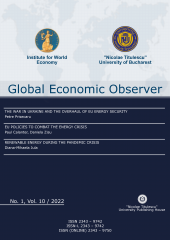Global Economic Observe
No. 2, Vol. 11 / 2023
SPATIAL DYNAMICS OF REGIONAL COMPETITIVENESS IN CENTRAL AND EASTERN EUROPE
Csaba Lakócai, Luigi Capoani
Abstract
Our study examines the territorial structure of 11 Central and Eastern European (CEE) Member States of the EU in NUTS 2 regional breakdown, considering the regional competitiveness as of the situation over the last couple of years. We focus our research on the question whether the regional competitiveness scores of the CEE regions are spatially auto-correlated. Then, we further analyze the determinants of the existing spatial concentrations. Methodologically, we apply quantitative analyses, including descriptive statistics and data visualization, as well as standard and spatial regression modeling. Our results confirm that the spatial neighborhood effect has a significant explanatory power for the regional competitiveness in CEE. Besides that, developing the high technology and knowledge intensive sectors, together with fostering social integration and inclusion, are crucial for improving the competitiveness of the CEE regions.
Keywords: Central and Eastern Europe, Regional Competitiveness, Spatial Development
JEL Classification: C21, C31, N94, R11, R12
Abstract
The Coronavirus pandemic marked the end of an era in the catching-up process of East-Central Europe. A thorough evaluation of the growth model of the last decade is therefore needed in order to draw lessons for future industrial policy. The aim of this article is to provide a comparative analysis of the Bulgarian, Hungarian and Romanian growth models based on the examination of leading sectors. The paper compares the five leading sectors of the three countries in the period 2011-2018. The five leading industries are defined in terms of their contribution to gross value-added growth. The paper also examines foreign dependence and labour productivity growth in the leading sectors, the latter also being key to analysing the possibility of a middle-income trap. The results show a different sectoral specialisation in the three countries. The foreign dominance is higher in Hungary and Romania. Moreover, Romania is the best performer in terms of labour productivity.
Key-words: growth models, leading sectors, catching-up, middle-income trap, dependency, industrial policy
JEL Classification: O14, O52, P52



